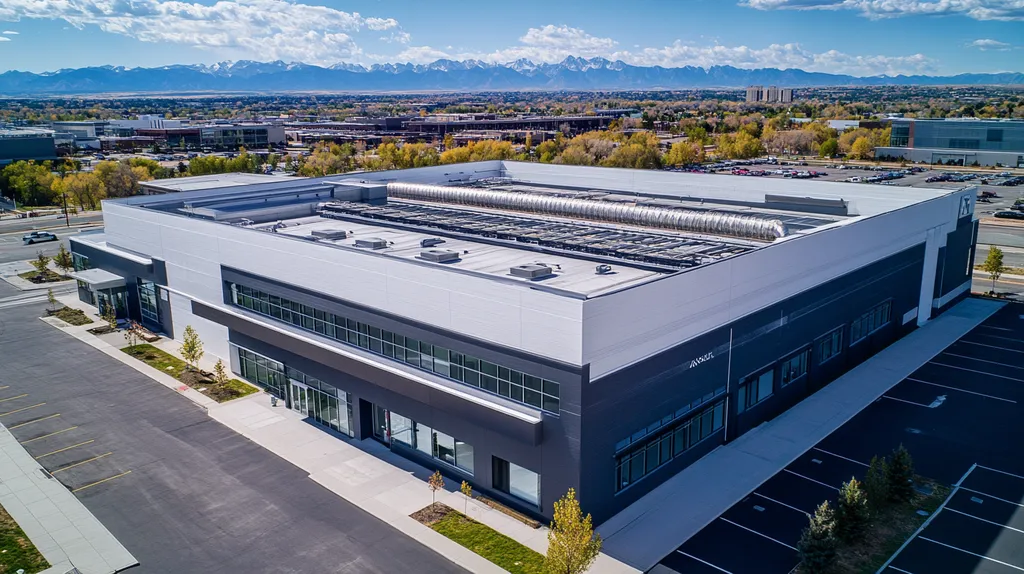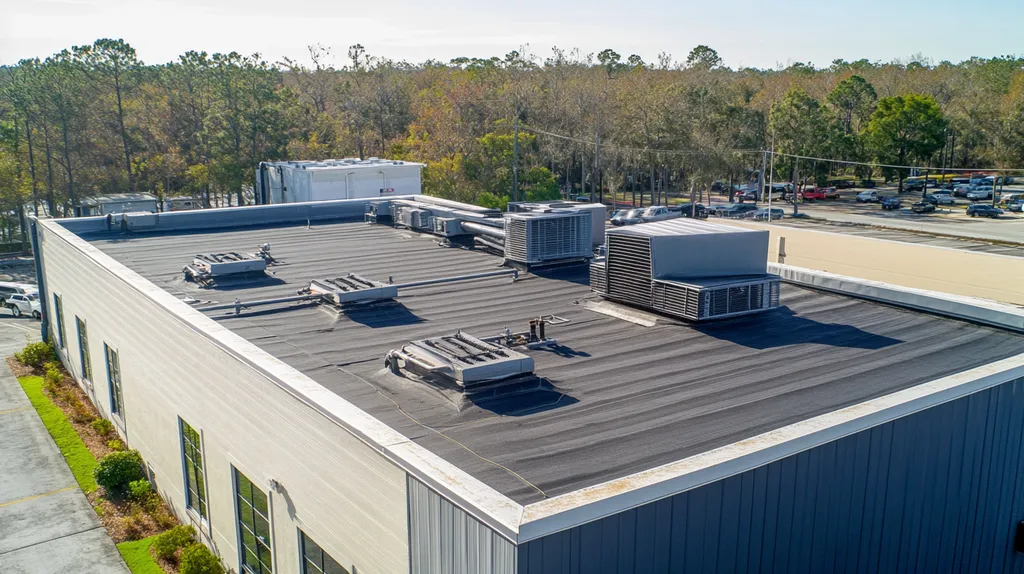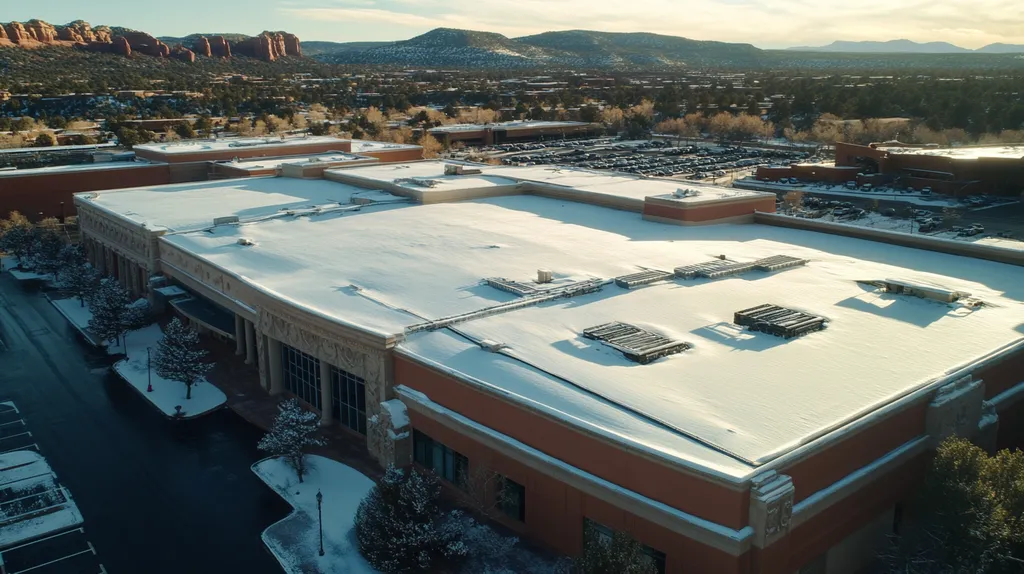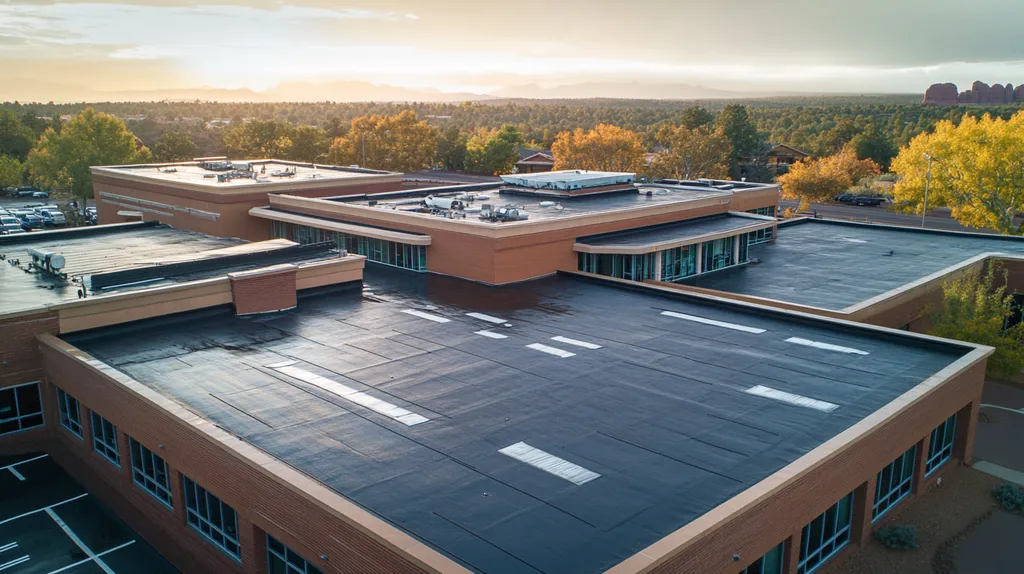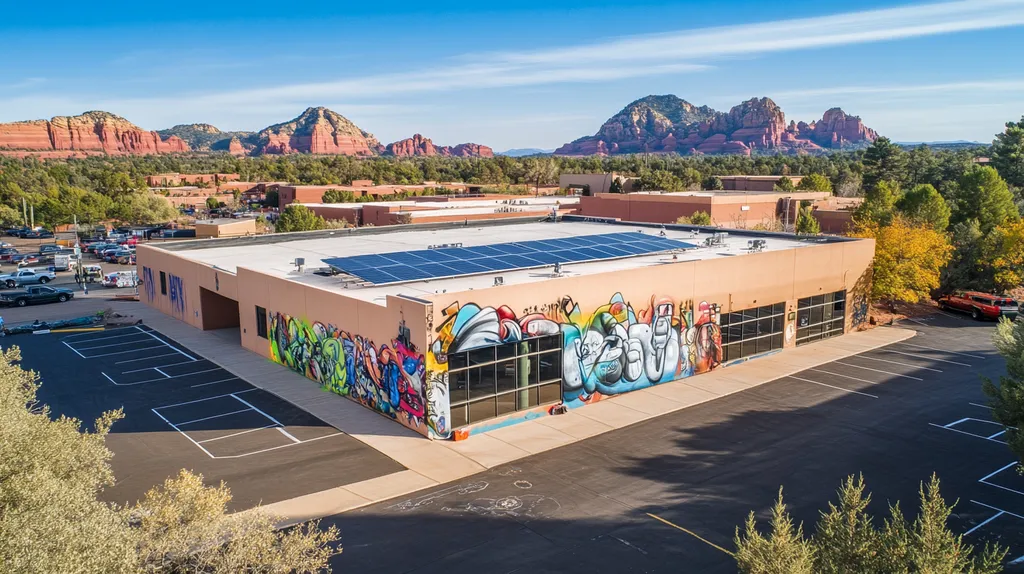Industrial roof failure costs U.S. businesses over $2.5 billion annually in damages, with 70% of these incidents directly linked to inadequate maintenance planning.
For facility managers and property owners, implementing a comprehensive roof maintenance plan isn’t just about preventing leaks—it’s about protecting valuable assets, ensuring operational continuity, and managing long-term costs effectively.
This handbook provides a systematic approach to industrial roof maintenance, covering everything from fundamental roofing concepts to advanced optimization strategies using modern technology and best practices.
SECTION 1: FUNDAMENTAL CONCEPTS
Industrial roofing is a critical yet often neglected component of facility management. Its condition can directly affect safety, operational efficiency, and overall costs. Neglecting roof maintenance can lead to unexpected leaks, energy inefficiencies, and significant structural damage. Alarmingly, 25% of commercial property owners face surprise roof failures, highlighting the urgent need for a solid maintenance plan. This section delves into the various types of industrial roofing systems, their material characteristics, and the lifecycle and durability factors that impact their long-term performance.
Types of Industrial Roofing Systems
Recognizing the different types of roofing systems is vital for property owners and facility managers. The most prevalent industrial roofing options include built-up roofing (BUR), single-ply membranes, and modified bitumen. Each has its own installation methods and performance characteristics. For instance, BUR systems are layered for enhanced durability but require diligent maintenance to avoid water pooling.
Single-ply membranes like TPO and PVC are favored for being lightweight and energy-efficient. While they are generally easier to install, they can be vulnerable to punctures from foot traffic. Meanwhile, an emerging trend toward green roofs offers benefits in insulation and stormwater management, although they necessitate specific structural considerations.
When selecting a roofing system, property owners must weigh factors such as climate, building usage, and budget. Making the right choice not only prolongs the roof’s lifespan but also enhances energy efficiency and overall building performance.
Choosing appropriate roofing systems is essential for establishing an effective maintenance plan. A well-informed decision lays the foundation for proactive strategies that can prevent minor issues from escalating into costly repairs.
Roofing Material Characteristics
The performance and maintenance needs of roofing materials are shaped by their individual characteristics. Common materials such as EPDM, TPO, and metal each have distinct advantages and challenges impacting their durability. For example, EPDM is celebrated for its weather resistance and longevity, yet its dark color can trap heat, increasing cooling costs.
Metal roofing is known for its strength and resistance to environmental factors, though it may require routine inspections to manage rust. Familiarity with these material attributes enables facility managers to create tailored maintenance strategies. Routine inspections help in catching damage early, avoiding expensive repairs.
Additionally, the lifespan of roofing materials is often tied to warranty provisions. Manufacturers typically offer warranties ranging from 10 to 30 years, but understanding specific maintenance obligations is critical to keeping those warranties valid. By aligning material characteristics with diligent care, facility managers can optimize roof performance.
Investing in high-quality materials may entail higher initial costs but can lead to significant long-term savings. This highlights the importance of making informed material selections in the development of a robust industrial roof maintenance plan.
Lifecycle and Durability Factors
The longevity of an industrial roof hinges on several durability factors that facility managers must consider. Environmental forces such as UV exposure, temperature swings, and rainfall can significantly impact a roof’s lifespan. For instance, roofs exposed to harsh sunlight may age more quickly, necessitating more frequent evaluations.
Proper installation is critical in determining durability. A poorly installed roofing system can fail prematurely, leading to unexpected expenses. Engaging qualified professionals for installation and ongoing maintenance is crucial to ensuring the roof endures environmental stresses effectively.
Additionally, effective drainage plays a vital role in managing roof lifecycle. Standing water can accelerate degradation, while a well-designed drainage system can extend the roof’s usability. Regular maintenance checks are crucial for verifying that drainage pathways are clear and functional.
By actively monitoring these aspects, property owners can greatly prolong their roofing systems’ lifespan. Crafting a comprehensive maintenance plan that addresses these variables is fundamental for safeguarding investments and ensuring uninterrupted operational performance.
SECTION 2: SYSTEM COMPONENTS
Poor maintenance of industrial roofs accounts for a staggering 30% of all roof failures. This statistic highlights the urgent need for property owners to have a solid grasp on every component of their roofing systems. Understanding roof coverings, flashing details, and drainage systems is essential for avoiding significant repair costs and ensuring longevity. Each of these components plays a critical role in maintaining the roof’s structural integrity and effectiveness, making comprehensive maintenance strategies vital.
Roof Covering and Membranes
The roof covering serves as the first line of defense against environmental elements such as rain, UV rays, and temperature changes. It is crucial to recognize its importance in preserving the underlying structure. Common materials like TPO, EPDM, and modified bitumen each come with distinct properties and maintenance requirements. Conducting regular inspections to check for wear and tear, including cracks and blisters, is essential, as these issues could signal a looming failure.
Waterproof membranes are particularly important; they prevent water infiltration, which is a leading cause of internal damage. Ensuring the integrity of these membranes is critical, not just for maintenance purposes, but for protecting the entire facility beneath. If undiscovered, even minor breaches can escalate into major problems.
Energy efficiency is another consideration tied to roof coverings. Reflective membranes, for instance, can help lower cooling costs by directing sunlight away from the building. A well-informed decision regarding the selection of roof coverings can lead to substantial long-term savings.
Focusing on the condition of the roof covering and membranes allows property owners to extend the lifespan of their roofing systems while ensuring their facilities remain safe and functional.
Flashing and Perimeter Details
Flashing is critical at joints and transitions, shielding these vulnerable areas from water intrusion. Commonly found around structures like chimneys, skylights, and vents, it is essential for driving moisture away from these joints. When flashing is poorly installed or damaged, it can lead to severe leaks that often go unnoticed until extensive damage has already occurred.
Regular inspections must prioritize flashing integrity. Any signs of rust, cracking, or improper sealing should prompt immediate repairs or replacements. This proactive approach significantly reduces the risk of moisture penetration and the costly structural damage that can follow.
Similarly, attention must be given to perimeter details, including edge metals and drip edges. These components play a vital role in directing water runoff away from the roof structure. If neglected, they can become points where water accumulates, which can deteriorate roofing materials prematurely.
In any industrial roof maintenance plan, maintaining the effectiveness of flashing and perimeter details is imperative as these elements are primary defenses against water damage.
Drainage and Gutter Systems
Effective drainage systems are essential in managing water flow on industrial roofs. Blocked or inadequately designed gutters can lead to pooling, significantly increasing the likelihood of membrane failure and compromising structural stability. Often, the risks of water pooling become clear only after leaks have already manifested, leading to more complex repairs.
Routine cleanouts and inspections of drainage systems are essential to maintaining functionality. Clearing debris from gutters and downspouts ensures smooth water flow and minimizes the chances of backflow. Property owners are advised to assess their systems’ capacity to handle heavy rainfall, especially in regions prone to deluges.
Moreover, a properly functioning drainage system enhances the overall longevity of the roofing system. It relieves stress from the roof covering, helping to prevent material deterioration. By prioritizing drainage, property owners can protect their investments and maintain the integrity of their roofs.
Incorporating effective drainage and gutter systems into a comprehensive maintenance strategy is crucial for safeguarding roofs against water-related issues, thus ensuring structural durability for years to come.
SECTION 3: IMPLEMENTATION METHODS
Implementing an industrial roof maintenance plan effectively is essential for tackling potential issues before they develop into costly repairs. Research indicates that proactive maintenance can slash repair expenses by as much as 50% compared to waiting for problems to arise. By identifying vulnerabilities early, property owners can extend the lifespan of their roofs, protecting both their investment and the daily operations of their facilities. This section details the key steps: beginning with an initial roof survey, setting a regular inspection schedule, and recognizing the importance of assessments after extreme weather events.
Initial Roof Survey and Assessment
A comprehensive initial roof survey is a critical first step in any maintenance strategy. This in-depth assessment evaluates the current condition, structural integrity, and existing vulnerabilities of the roof. Experts may utilize advanced technologies like infrared thermography and moisture surveys, which help uncover hidden issues that aren’t easily visible to the naked eye.
The results of this initial evaluation lay the groundwork for the maintenance plan, guiding critical decisions on both repairs and potential upgrades. Property owners can prioritize urgent areas of concern, which helps mitigate risks before they escalate. It is important to create a detailed report that outlines necessary actions, along with their respective timelines.
Neglecting this essential initial survey can lead to rising costs and avoidable roof failures. As roofs age, undetected problems can worsen, resulting in serious leaks or structural damage. A thorough assessment ensures that future maintenance decisions are based on solid data rather than assumptions.
Regularly updating this assessment, ideally every five years, is crucial as roof conditions and environmental factors evolve. Changes in roofing material performance and weather patterns can significantly affect maintenance needs, making continuous evaluation a cornerstone of effective management.
Scheduling and Frequency of Inspections
Setting a regular inspection schedule is vital for maintaining the health of an industrial roof. It is generally advised that facilities conduct inspections at least twice a year, preferably in spring and fall. This proactive approach allows for early detection of seasonal wear, tear, or any environmental damage that may have occurred.
Facilities subject to severe weather conditions or heavy foot traffic should consider increasing the frequency of their inspections. Tailoring the inspection schedule to the specific needs of each roof type and environment enables targeted maintenance. Regular inspections have proven effective at catching minor issues before they evolve into costly repairs.
During each inspection, focus should be placed on crucial areas such as seam integrity, drainage systems, and the surface condition. Documenting the results meticulously is important to track changes and performance over time. This documentation supports evaluation and justifies maintenance expenditures when necessary.
By disregarding a scheduled inspection plan, property owners risk unforeseen expenses and disruptive operational downtime. Being proactive about inspections empowers facility managers to plan their budgets more effectively, avoiding the financial drain of emergency repairs.
Post-Storm and Construction Inspections
Post-storm inspections are absolutely essential and should take place immediately following any severe weather events. High winds, heavy snowfall, or hail can inflict hidden damage that requires prompt assessment. Early interventions can prevent complications like leaks or structural failures, which can arise if damage goes unchecked.
Additionally, new construction or installation work can impact existing roofs. Conducting inspections after such projects is vital to ensure that no damage has occurred and that all new elements meet safety and performance standards. This can save property owners from future frustrations and unexpected costs related to unresolved issues.
Documenting the outcomes of post-storm and construction inspections contributes to a comprehensive maintenance record. This information can be invaluable for both future planning and budgeting decisions, facilitating informed choices regarding repairs and renovations.
By establishing a protocol for these inspections, property owners can maintain their roofs’ functionality and enhance overall building safety. Regular evaluations help facility managers stay informed about their roofs’ conditions, promoting responsible investment in ongoing maintenance and repairs.
SECTION 4: MAINTENANCE REQUIREMENTS
In the world of industrial roofing, proactive maintenance isn’t just a good idea; it’s crucial. Neglecting maintenance can result in leaks, structural issues, and even costly operational shutdowns, with repair expenses skyrocketing. By investing in a solid maintenance plan, facility managers can ensure safety, extend the lifespan of their roofs, and protect their property values. This section outlines the essential components of an effective maintenance strategy, focusing on regular inspections, preventive tasks, and the necessary procedures for repairs and replacements.
Regular Inspection Checklists
Regular inspections form the bedrock of an effective maintenance plan. A well-structured checklist ensures that no crucial areas go unchecked. Inspectors should focus on seams, flashings, and drainage systems, as these are common points of failure. By documenting each inspection, potential trends can be identified, allowing for early intervention before problems escalate.
Incorporating seasonal inspections, especially before and after severe weather, further enhances roof protection. For instance, heavy rain can shift debris, blocking drainage systems. Using a standardized checklist streamlines the inspection process, ensuring consistent quality and thoroughness.
Engaging a certified roofing professional for detailed evaluations can reveal hidden issues that might otherwise go unnoticed. With routine inspections backed by thorough record-keeping, facility managers can not only prolong roof life but also bolster their budgeting and planning efforts for the future.
Preventive Maintenance Tasks
Preventive maintenance strategies are crucial for slowing roof deterioration. Regular tasks, such as cleaning gutters and removing debris, should be performed consistently. Clogged gutters can trap moisture, leading to leaks and extensive damage if left unchecked.
Additionally, sealing joints and flashings is a key preventive measure. As materials age, seals may degrade, making it essential to monitor and maintain these areas to prevent water infiltration. By addressing these vulnerabilities early, facility managers can avoid more significant and costly repairs down the line.
Moreover, scheduling maintenance sessions, ideally every six months, helps to maintain overall roof integrity. Taking proactive steps creates a safe environment, which is vital for any industrial facility’s operations.
Repair and Replacement Procedures
Timely repairs are essential for preventing minor issues from escalating into major problems. A comprehensive emergency response plan enables facility managers to address damage swiftly. Such a plan should detail procedures for immediate repairs, ensuring safety while effectively mitigating leaks or structural concerns.
When repairs become impractical, a well-considered replacement strategy must be put into place. Recognizing signs of end-of-life, such as frequent leaks or significant wear, is vital in determining when replacement is necessary. Monitoring repair costs is also critical; high expenses may signal that a new roof is in order.
Finally, keeping detailed records of repairs and replacements aids in future budget forecasting. This organized history simplifies the transition to new roofing systems when the time comes, allowing for sustained operational efficiency within the facility.
SECTION 5: PERFORMANCE METRICS
Understanding the performance metrics of industrial roofs is essential for property owners and facility managers. Regular maintenance isn’t merely a suggestion; it is a necessity that directly impacts the roof’s lifespan and overall efficiency. Studies reveal that neglecting routine care can reduce a roof’s lifespan by up to 30%. This section will explore key performance metrics, focusing on condition assessments, damage identification, and maintenance prioritization.
Condition Assessment and Reporting
Conducting regular condition assessments is fundamental to preserving the integrity of industrial roofs. At least twice a year, these assessments should be performed to spot early signs of wear or damage, including cracks, pooling water, and blisters. A systematic evaluation should include a checklist, allowing professionals to document findings in a report that captures both the roof’s current state and changes over time.
This documentation is vital; it helps track the roof’s health and identifies any worsening issues requiring immediate attention. Advanced tools such as thermal imaging cameras and drones can enhance inspections, offering more detailed insights than traditional methods alone. Investing in these technologies ensures comprehensive assessments, minimizing the chances of overlooking critical areas.
By consistently conducting condition assessments, facility managers foster a proactive maintenance culture. This not only reduces the need for emergency repairs but also results in substantial long-term savings.
Identifying Areas of Damage or Wear
Spotting damage on industrial roofs involves looking deeper than just visible signs. Common issues like punctures, seam failures, and excessive ponding can lead to significant leaks if not addressed quickly. Each identified problem requires tailored attention and specific mitigation strategies.
Regular assessments help uncover not only visible damage but also potential underlying issues that might cause future complications. For instance, early detection of rust on metal flashing can prevent more severe structural failures. Documenting these findings creates a roadmap for effective future maintenance, ensuring that no aspect goes unnoticed.
Facility managers should utilize manufacturer guidelines and industry standards to guide their evaluations. Empowering trained staff or hiring external professionals can further enhance these assessments. A knowledgeable team is crucial for timely identification and effective resolution of problems.
Addressing issues early can lead to less costly and less disruptive repairs, ultimately maintaining roof efficiency and extending its lifespan.
Prioritizing Repairs and Maintenance
The next crucial step is prioritizing repairs based on the data gathered from assessments. Not all problems are equally urgent or impactful, and classifying them accordingly ensures efficient allocation of resources. For example, a significant leak in a crucial area should take precedence over minor surface blisters.
Creating an action plan based on damage severity aids in decision-making, helping to prevent cascading failures that could lead to extensive structural harm. Facility managers should closely collaborate with roofing contractors to develop realistic timelines and budgets for these repairs, ensuring that urgent fixes are executed promptly.
Integrating performance metrics into routine maintenance schedules establishes a framework for ongoing improvement. Regularly tracking historical data against benchmarks promotes accountability and a sustained quality of roof management.
Ultimately, a methodical approach to prioritizing maintenance actions can protect investments and ensure that roofing systems remain functional for years to come.
SECTION 5: PERFORMANCE METRICS
Effective roof maintenance is not just recommended; it’s a necessity that greatly influences the durability and efficiency of industrial buildings. Neglected roof care can shorten a roof’s lifespan by as much as 30%, leading to increased costs and operational disruptions. Property owners and facility managers must grasp how to evaluate roof performance holistically. This section explores critical performance metrics, focusing on conducting condition assessments, identifying damage, and prioritizing necessary repairs.
Condition Assessment and Reporting
Regular condition assessments are a cornerstone for maintaining the structural integrity of industrial roofs. Conducting thorough evaluations at least twice a year allows for timely identification of wear and damage. Key indicators to watch for include membrane cracks, pooling water, and blisters.
Using a detailed checklist, professionals can methodically evaluate the roof and document their findings in a comprehensive report. This report should capture both the roof’s current condition and any changes over time, which helps track health and performance. For example, comparing current assessments with previous ones can highlight worsening issues prompting urgent attention.
Incorporating advanced tools like thermal imaging cameras or drones enhances traditional inspection methods significantly. These technologies provide a more accurate and comprehensive view, ensuring that no critical areas are overlooked. Investing in such innovations can improve the accuracy of assessments and speed up the detection of potential issues.
By consistently performing condition assessments, facility managers foster a proactive maintenance environment. This reduces the likelihood of emergency repairs and leads to substantial long-term savings.
Identifying Areas of Damage or Wear
Spotting damage on industrial roofs requires a keen eye that goes beyond surface-level observations. Common problems like punctures, seam failures, and excessive ponding can lead to significant leaks if not addressed quickly. Each of these issues demands targeted attention and tailored intervention strategies.
Regular assessments reveal not just visible damage, but also underlying issues that could lead to future complications. For instance, early detection of rust on metal flashing can prevent more severe structural failures later. Documenting such findings creates a valuable roadmap for future maintenance actions.
Facility managers should utilize various resources, including manufacturer guidelines and industry standards, to inform their evaluations. Whether empowering trained staff or hiring external professionals, having a knowledgeable team is essential for the timely identification and effective resolution of issues.
Addressing issues promptly leads to less costly and less disruptive repairs, ultimately maintaining the roof’s efficiency and extending its lifespan.
Prioritizing Repairs and Maintenance
With a comprehensive array of data from assessments, it becomes crucial to prioritize repairs. Not every problem holds equal importance in terms of urgency and impact. Classifying issues based on severity ensures that resources are allocated effectively.
For example, a significant leak in a vital area should take precedence over minor surface blisters. Developing an action plan based on the severity of damage aids in informed decision-making. This strategic approach helps prevent cascading failures, reducing the risk of extensive structural harm.
Collaboration with roofing contractors is essential for setting realistic timelines and budgets for necessary repairs. Clear communication accommodates operational needs while ensuring that urgent repairs are completed promptly.
Moreover, integrating performance metrics into routine maintenance schedules establishes a framework for continuous improvement. Tracking historical data against benchmarks fosters accountability and ensures sustained quality in roof management.
The Bottom Line
With industrial roof failures costing businesses billions annually, implementing a comprehensive maintenance plan isn’t optional—it’s essential for survival.
The data is clear: proactive maintenance reduces repair costs by up to 50% while extending roof life by decades.
Success requires integrating all key components: regular inspections, preventive maintenance, performance tracking, and optimization through modern technology.
Facility managers who implement the strategies outlined in this handbook position themselves to protect their assets, maintain operational continuity, and significantly reduce long-term costs.
The choice is simple: invest in systematic maintenance now or face costly emergency repairs and potential structural failure later.
FREQUENTLY ASKED QUESTIONS
Q. What are the key factors affecting an industrial roof’s performance?
A. The main factors include environmental exposure, installation quality, and roof material types. UV rays, temperature fluctuations, and drainage issues significantly impact the roof’s lifespan. Choosing the right materials and ensuring proper installation can prevent potential failures.
Q. How can I identify different types of commercial roofs?
A. Identifying different roofing types involves recognizing materials and structures used. Built-up roofing, single-ply membranes, and modified bitumen each have distinct appearances and performance characteristics. Consulting with a roofing professional can provide clarity on what type is appropriate for your facility.
Q. Why is an initial roof survey important for maintenance plans?
A. An initial roof survey identifies existing vulnerabilities and establishes a baseline for future assessments. It informs property owners about critical repairs and helps prioritize maintenance actions necessary to protect the facility from potential issues.
Q. What preventive tasks should be included in an industrial roof maintenance plan?
A. Preventive tasks include regular gutter cleanouts, debris removal, and sealing any joints. Maintaining these components helps avoid costly leaks and extends the roof’s lifespan by addressing vulnerabilities early.
Q. How can I assess the condition of my industrial roof effectively?
A. Conduct systematic condition assessments at least twice a year. Use checklists to document findings such as cracks, wear, or pooling water. Advanced tools like drones or thermal imaging can enhance the evaluation process, revealing hidden issues.
Q. What should I do after a severe weather event regarding my roof?
A. Perform a post-storm inspection to assess potential damage from high winds or heavy rain. Document any findings and address urgent repairs promptly to prevent leaks or structural failures. Regular assessments are key to maintaining roof integrity.
Q. What performance metrics should I track for my industrial roof?
A. Track metrics such as condition assessment results, repair frequency, and water penetration instances. Prioritizing repairs based on severity documented in assessments helps ensure effective roof management and sustain operational efficiency.

